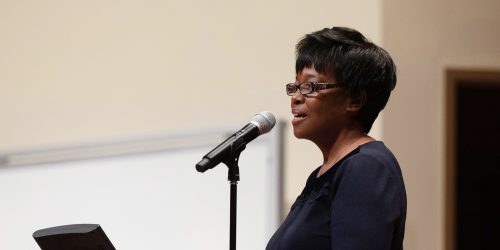
Ramona Hyman, chair and professor of English at Oakwood University, spoke for the 12th annual John O. Waller Lectureship on the Arts | Photo credit: Lloyd Martinez
On Wednesday evening, October 23, the Andrews University Department of English hosted their 12th annual John O. Waller Lectureship on the Arts program in Newbold Auditorium, Buller Hall. The speaker, Ramona Hyman, chair and professor of English at Oakwood University, presented “Montgomery 55 on My Mind: Success Lessons from the Boycott.”
Started in 2008, the Waller Lectureship explores a variety of topics related to the arts. John O. Waller was a distinguished Seventh-day Adventist scholar and professor of English at Andrews University from the early 1960s to the late 1980s. He wrote a book titled “Circle of Friends: The Tennysons and the Lushingtons of Park House” published by Ohio University Press in 1986. Additionally, he was involved in research regarding Seventh-day Adventist and Ellen G. White attitudes toward fiction. The Waller Lectureship is largely funded by a contribution from Waller’s estate.
Past programs have included “An Evening with Charles Dickens” by Roger Jerome in 2009, “The Mass and the Theater: Othello and Sacrifice” by Regina Schwartz in 2013, “Neo-Slave Narratives: #SlaveLivesMatter” by Valerie Lee in 2016 and “Freud’s Last Session” starring Kenneth Wright and Brady Greer Huffman in 2017.
This year’s speaker, Ramona Hyman, has had her scholarly work included in numerous journals and anthologies such as Essence, African American Pulpit, African American Review, College Language Association Journal, Obsidian and Callaloo. She has been anthologized in Amiri and Amina Barka’s “An Anthology of African American Women Writers” (Marrow Press), and she is the author of two collections of poetry, “In the Sanctuary of a South” and “I Am Black America.”
An alumna from Andrews University with her master’s degree, Hyman began her address by reminiscing about her time on the Andrews University campus. She then transitioned to her topic: the 1955 Montgomery bus boycott.
“Everything that I do professionally grows from the lessons I have learned from Montgomery,” Hyman said.
After explaining her goal that each audience member would learn from these lessons, Hyman began a retelling of the historical event.
It all started on Thursday, Dec. 1, 1955, when Rosa Parks walked onto the bus and sat in the last of the first ten seats. During this time of bus segregation, this section was commonly known as “no man’s land.”
“She sat, and she was tired,” Hyman explained. “Sometimes it is okay to just be tired. Tired compels change. She was tired.”
Hyman continued the story, giving a detailed explanation of how Rosa Parks stayed seated, began to cry, and was ultimately arrested.
“We can sit anywhere we want because she cried. Because she understood that to move Montgomery forward, she would have to cry,” Hyman said.
Hyman pressed forward in her dramatic retelling, noting the importance of Jo Ann Robinson, the English professor at Alabama State College (now Alabama State University) who wrote and passed out the leaflets calling for a one-day bus boycott. Hyman also explained how Martin Luther King Jr., then a new pastor at the Dexter Avenue Church in Montgomery, was elected as the president for the newly established Montgomery Improvement Association (MIA). Hyman cites King’s response to this call as one of the many lessons that she takes from this event.
“You don’t have to be in the room to be called to lead the room, but you have to be ready when you’re called to lead the room,” she said.
Hyman continued, explaining how the bus boycott lasted for 382 days until Dec. 20, 1956, the same day that the U.S. Supreme Court ordered integrated Montgomery buses. This decision came as a result of the Browder v. Gayle court case, filed by Fred Gray and Charles D. Langford.
As she wrapped up her presentation, Hyman emphasized the role that faith played in the Civil Rights movement, noting that the boycott began and ended in a church.
“The Civil Rights movement was grounded in a Christian ethos of activism where Jesus was at the center,” she explained. “It teaches me that I can be a Christian and I can be an activist and I can participate fully in the public square.”
Hannah Gallant, University Communication student writer